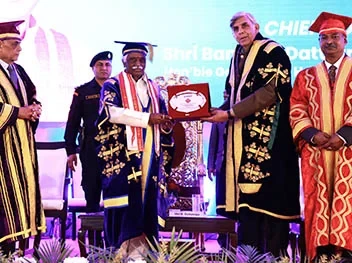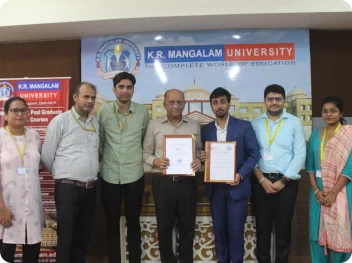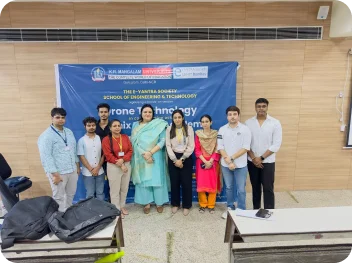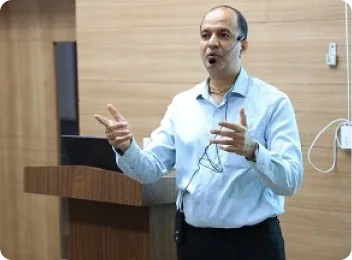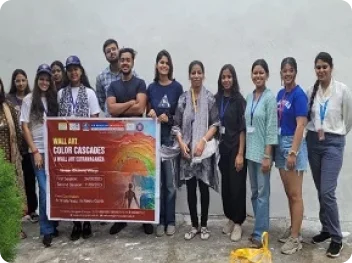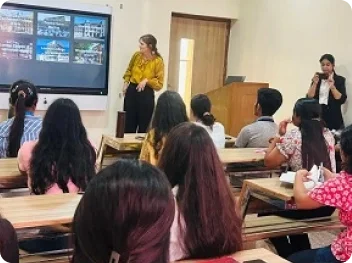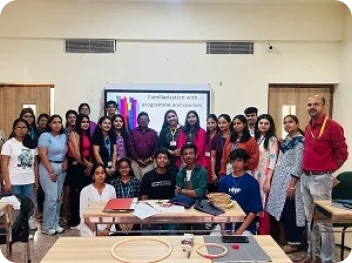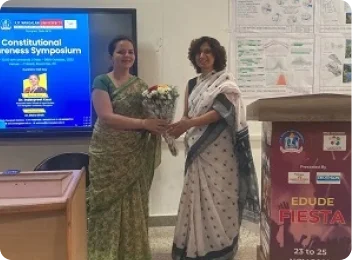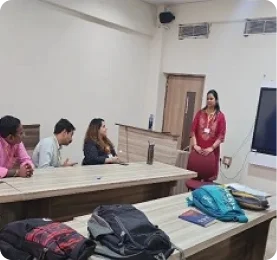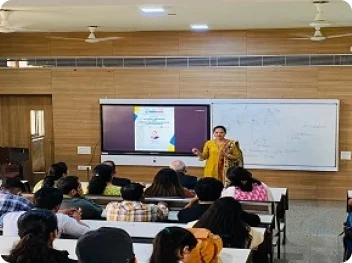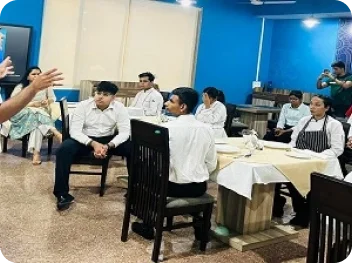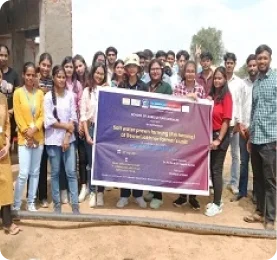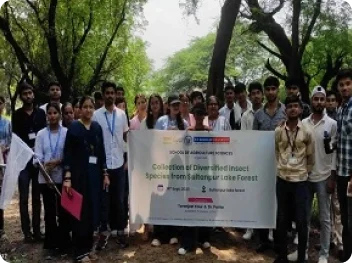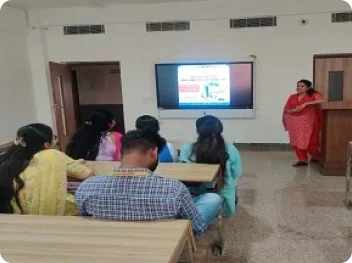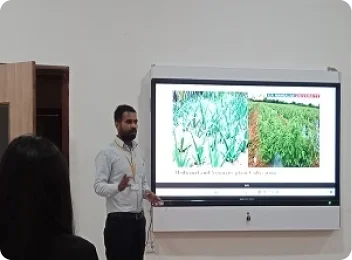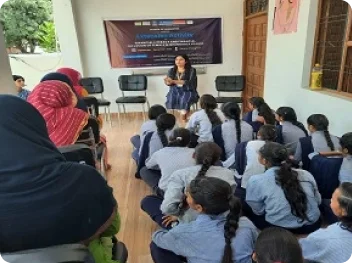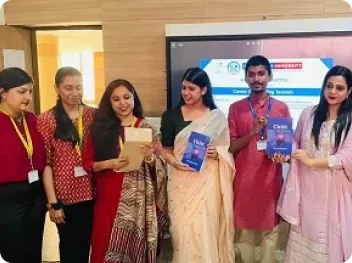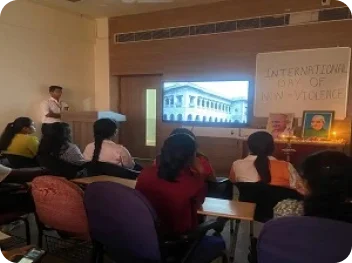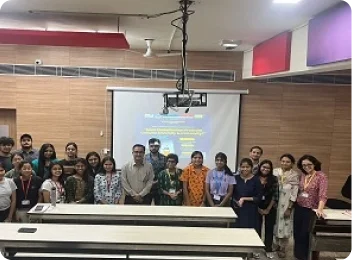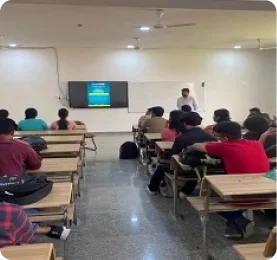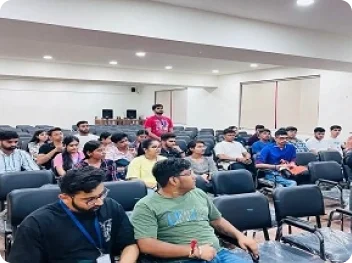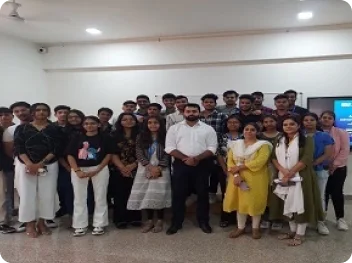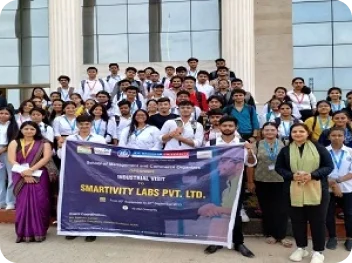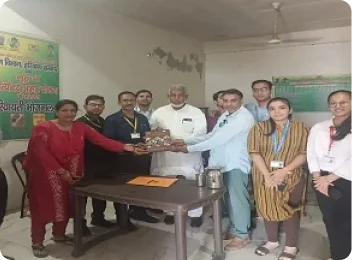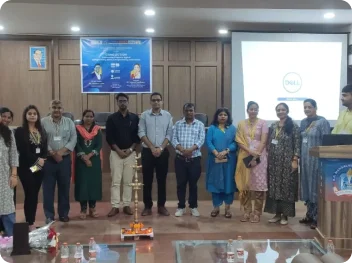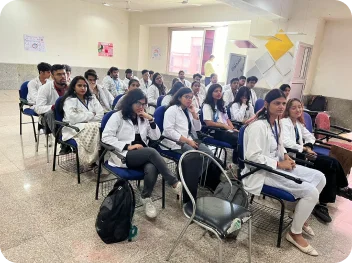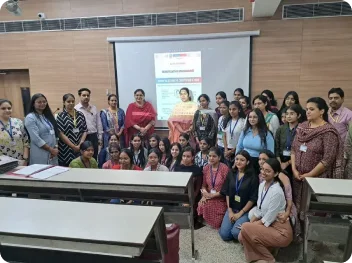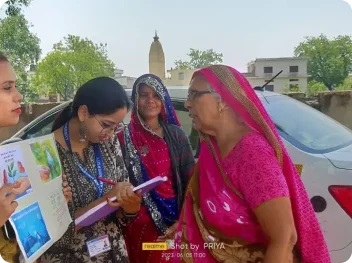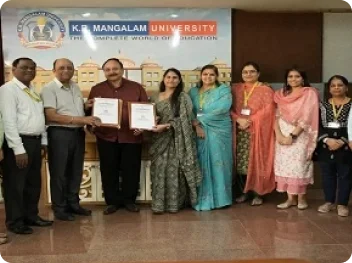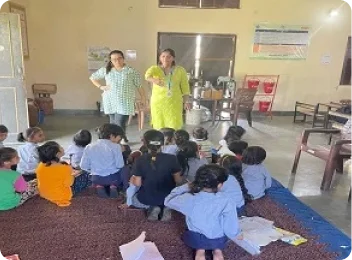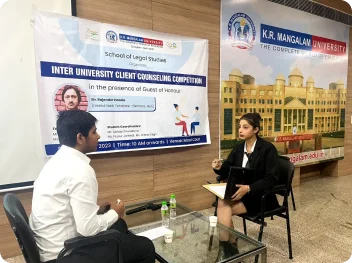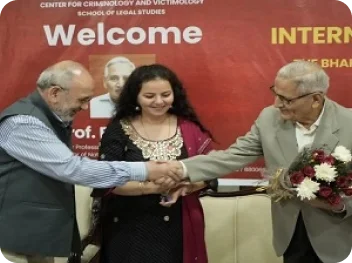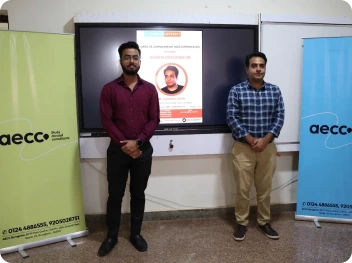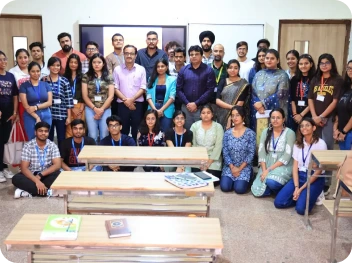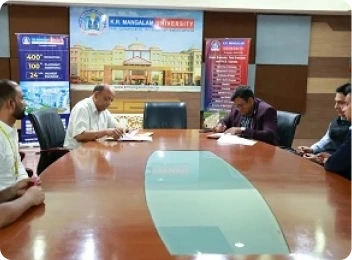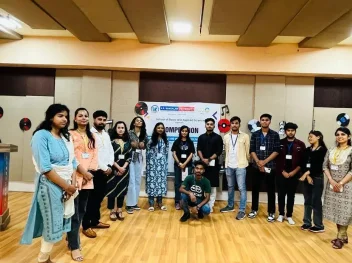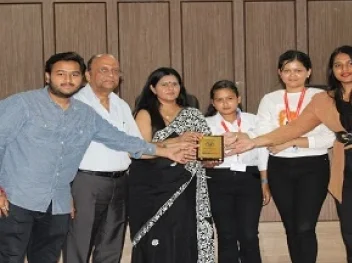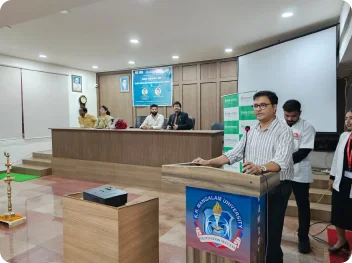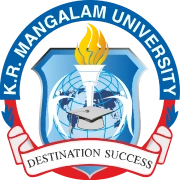


A Life Beyond Academics
Welcome to a world where education meets excitement! At K.R. Mangalam University (KRMU), we believe that university life should be a perfect blend of learning, growth, and fun. Our campus is not just a place to study; it’s where you’ll make memories that last a lifetime.

Facilities That Foster Excellence
Innovate
Engage
Succeed
Immerse yourself in an environment where every day is an opportunity to explore, learn, and connect. Our sprawling campus is a bustling hub of activities, events, and interactions that foster a sense of belonging and community.
What’s Happening at KRMU
Stay Updated with Campus Happenings
Rendezvous
K.R. Mangalam University celebrated its two days Inter-University annual fest [...]
Delhi Times Fashion Week
The Fashion Design department of KR Mangalam University at Delhi [...]
Edude Fiesta 2023 (Day-1)
K.R. Mangalam University successfully inaugurated the grand and vibrant two-day [...]
International Conference on Multidisciplinary Research & Innovation
School of Engineering and Technology hosted a prestigious two-day International
Training Session on Drone Technology
The E- yantra society, School of Engineering and Technology organised [...]
Expert Talk on “Placement Process for Dream Companies”
For Motivating and providing deep insights of the placement drive [...]
Seminar on Portfolio Guidance
School of Architecture and Design, Fashion Design Department had the [...]
Workshop on Velvet Embroidery
School of Architecture, Department of Fashion Design, is thrilled to [...]
Constitutional Awareness Symposium
School of Architecture and Design organized an event on ‘Constitutional [...]
Session on professional ethics in hospitality and tourism
School of Hotel Management and Catering Technology organized a session [...]
International Housekeeping Week
As a continuation of International Housekeeping week the Students of [...]
Session on Professional Ethics for students
School of Legal Studies successfully organised an event, "Professional Ethics [...]
Career Counselling Session
School of Hotel Management and Catering Technology conducted a career [...]
Extension Activity on Small Scale Restaurant
School of Hotel Management and Catering Technology in collaboration with [...]
Extension Activity on Salt Prawn Farming
School of Agricultural Sciences, KRMU in collaboration with the AAE [...]
Extension Activity on Collecting Insects
The Sultanpur Lake Forest (Sultanpur National Park) was visited by [...]
SOAS Lecture on Professional Ethics
School of Agricultural Sciences conducted a lecture on professional ethics [...]
Vriksha Ropan Celebration
School of Agriculture Sciences in collaboration with NSS, organized a [...]
Expert Lecture On Career Opportunities in Agriculture
School of Agricultural Sciences at K R Mangalam University organised [...]
Interactive Session with Chinese Diplomats
A delegation of the diplomats and officials from the Embassy [...]
Extension Activity on Financial Literacy
“Financial literacy is a fundamental skill that empowers individuals to [...]
International Day of Non Violence Celebration
School of Humanities organized "International Day of Non-Violence (2nd October)" [...]
Debate Competition
School of Humanities successfully organized an Intra University Debate Competition [...]
Seminar on Student Investment Fund
K.R. Mangalam Investment Club organized a seminar on the topic [...]
Session on Peak Performance
Chetna Society organized a session on “Peak Performance: Unleashing the [...]
Alumni Talk on Career Advancement
School of Managment and Commerce organized an Alumni Talk Session [...]
Industrial Visit to Smartivity Labs Pvt. Ltd.
School of Management and Commerce organized an industrial visit to [...]
Extension activity on Financial Inclusiveness
School of Management and Commerce organized an extension activity on [...]
Hands on training session
School of Medical and Allied Sciences in collaboration with Scrollwell.com [...]
CONCOCTION “Intellectual Property Rights”
School of Medical and Allied Sciences organized a technical session [...]
Medical and Allied Sciences Alumni Session
School of Medical and Allied Sciences conducted an alumni session. [...]
Extension Activity on Drug Addiction
In a proactive effort to combat the growing threat of [...]
Sensitization Programme
The School of Education organised a sensitization programme on Constitutional [...]
World Environment Day
School of Education In collaboration with NSS organizes an Extension [...]
MOU signing with Sociwind Foundation
A momentous occasion unfolded as the School of Education,KRMU and [...]
MOU with Save Aravali Trust
School of Education, K. R. Mangalam University and Save Aravali [...]
Extension activity on Enhancing Proficiency in Reading (Phase 11)
School of Education continued its commitment to community development with [...]
Client Counseling Session
School of Legal Studies, K.R. Mangalam University organized an inter-university [...]
Awareness Camp on Menstrual Hygiene
School of Legal Studies in collaboration with NSS, organised a [...]
Special Lecture on Rule of Law
School of Legal Studies organized a Special Lecture- V on [...]
Awareness Drive on reducing inequality
School of legal studies organised an extension activity titled "Awareness [...]
Career Counseling Session on Higher Education
School of Journalism and Mass Communication at K R Mangalam [...]
Session on Film Studies
School of Journalism and Mass Communication organized a special session [...]
Special Session on Creator Economy Entrepreneurship
School of Journalism and Mass Communication organised an enriching alumni [...]
MOU signing with Newspaper Association of India
School of Journalism and Mass Communication, K. R. Mangalam University, [...]
Cultural Differences Celebrations
School of Basic and Applied Sciences organised a competition on [...]
Seminar on Career Counseling
School of Basic and Applied Sciences organized a seminar on [...]
Case Study on Drug Addiction
School of Basic and Applied Sciences conducted a visit in [...]
World Pharmacist Day
School of Medical & Allied Sciences celebrated “World Pharmacist Day”. [...]
Group Discussion on Unplastic India
Management Society organized a group discussion on ‘Unplastic India’ for [...]
Your
Well-Being
Our Priority
Student Welfare provides ample scope, opportunities, and facilities for the students’ all-around development of personality and leadership qualities. Here, all the activities are undertaken to promote opportunities for the youth to enhance their skills and talents to boost their confidence. Besides undertaking engagement activities regarding the facilitation of outcomes during and after the students’ pursuit of academic activities, the office acts as a channel of communication between the students and the university administration.
Your
Interest
Our
Platform
KRMU Clubs and Societies
Hear it from the
students themselves
Discover what our satisfied students and alumni have to say about their transformative experiences at KRMU

Akhilesh
Bachelor of Design (B.Des) (Interior Design)
I've enrolled in the bachelor of design program from K.R. Mangalam University, with high expectations and can confidently say that it has exceeded them all. The programme has fundamentally changed my perspective on creativity, not only as a designer but also as an overall creative thinker.

Samarth
Bachelor of Design (B.Des) (Interior Design)
I am delighted to share my positive experience with the Bachelor of Design (B.Des.) in Fashion Design program at K.R. Mangalam University. This institution has truly exceeded my expectations, providing a comprehensive and enriching education in the field of fashion design.

Sarthak
BFA
The emphasis on interdisciplinary collaboration is another aspect that sets KR Mangalam University apart. The opportunities to work with students from other disciplines foster a diverse and stimulating creative environment. This collaborative approach has broadened my perspective and enhanced my ability to express ideas through various artistic mediums.

Anushka Singh
B.Arch
The university actively promotes industry exposure through workshops, seminars, and guest lectures by renowned architects. This exposure has been crucial in bridging the gap between academic learning and the practical aspects of the profession.

Vihaan
B.Tech. CSE (AI & ML)
The B.Tech. CSE AI and ML programme has provided me with a solid foundation in computer science, and the specialised courses in AI and ML have pushed my intellectual boundaries. The challenging curriculum and dedicated faculty fueled my passion for technology.

Chirayu Gaur
B.Tech. CSE (UX/UI)
I am grateful to K.R. Mangalam University and its faculty for working so hard to mould me into a skilled corporate professional. Additionally, I want to express my gratitude to the faculty in the SOET CSE department for inspiring me to think broadly and spread my wings.

Rishi
B.Tech. CSE
As my B.Tech. journey comes to an end, I am confident that the skills, knowledge, and experiences I gained at K.R. Mangalam University will serve as a solid foundation for my future endeavours. I am grateful for the stimulating learning environment and the university's assistance in moulding me into a well-rounded and competent professional in the field of Computer Science and Engineering.

Vivek Kumar
B.Tech. CSE (FSD)
Choosing Full Stack Development specialisation changed my academic and professional trajectory significantly. K.R. Mangalam University's curriculum is meticulously designed to provide a thorough understanding of the most recent technologies and industry trends. Students are well-prepared for the dynamic field of Full Stack Development because of the combination of theoretical knowledge and practical applications.

Akhilesh
Bachelor of Design (B.Des) (Interior Design)
I've enrolled in the bachelor of design programme from K.R. Mangalam University, with high expectations and can confidently say that it has exceeded them all. The programme has fundamentally changed my perspective on creativity, not only as a designer but also as an overall creative thinker.

Samarth
Bachelor of Design (B.Des) (Interior Design)
I am delighted to share my positive experience with the Bachelor of Design (B.Des.) in Fashion Design programme at K.R. Mangalam University. This institution has truly exceeded my expectations, providing a comprehensive and enriching education in the field of fashion design.

Sarthak
BFA
The emphasis on interdisciplinary collaboration is another aspect that sets KR Mangalam University apart. The opportunities to work with students from other disciplines foster a diverse and stimulating creative environment. This collaborative approach has broadened my perspective and enhanced my ability to express ideas through various artistic mediums.

Anushka Singh
B.Arch
The university actively promotes industry exposure through workshops, seminars, and guest lectures by renowned architects. This exposure has been crucial in bridging the gap between academic learning and the practical aspects of the profession.

Ankit
B.HMCT
I am excited to share my experience as a Bachelor of Hotel Management and Catering Technology (B.HMCT) student at K.R. Mangalam University. My experience here has been nothing short of extraordinary, and I am confident that selecting this program was one of the best decisions I have ever made.

Mohit
B.HMCT
K.R. Mangalam's campus life is vibrant and diverse, fostering a sense of community among students. The university encourages extracurricular activities, and I have participated in a variety of hospitality-related events, competitions, and clubs. These activities not only enhanced my academic experience but also assisted me in developing important interpersonal and leadership skills.

Siya Narula
B.HMCT
K.R. Mangalam University's faculty goes above and beyond to help students grow academically and personally. They are approachable, encouraging, and always willing to offer advice. My mentorship has been instrumental in shaping my career goals and preparing me for the industry's challenges.

Vashnu Goswami
B.HMCT
The B.HMCT program at K.R. Mangalam University has been a rewarding and transformative experience. The extensive curriculum, hands-on training, and supportive environment not only prepared me for a successful career in the hospitality industry but also instilled in me a desire for excellence and a commitment to lifelong learning. I am proud to be a member of the K.R. Mangalam University community and would strongly recommend this program to anyone looking to succeed in the exciting world of hotel management and catering technology.

Ansar Khan
B.Sc. (Hons.) Agriculture
The university's commitment to providing modern facilities, including well-equipped laboratories and research centers, has significantly enhanced the learning experience. The collaborative and inclusive atmosphere among students has created a supportive community, fostering teamwork and the exchange of ideas.

Harsh Chaudhary
B.Sc. (Hons.) Agriculture
The program emphasizes experiential learning through hands-on activities, field trips, and practical training. These experiences have been beneficial in that they have allowed me to apply academic principles in real-world settings and build the skills required for a career in agriculture.

Nitish Kumar
B.Sc. (Hons.) Agriculture
"I'm happy to express my thanks and admiration for the amazing academic experience I had while pursuing KR Mangalam University's B.Sc. (Hons.) Agriculture degree. With its extensive and stimulating agricultural learning curriculum, this program has been a pillar of my education.

Shreyank Adhikari
B.Sc. (Hons.) Agriculture
In conclusion, I believe that KR Mangalam University's B.Sc. (Hons.) Agriculture program is both worthwhile and instructive. The curriculum has given me the knowledge and skills I need for a successful career in agriculture, and it has also deepened my appreciation of the critical role agriculture plays in shaping our planet. I'm happy to recommend the B.Sc. (Hons.) Agriculture program to people who are passionate about working in the agricultural industry."

Rasveer
B.A. (Hons.) Chinese
The curriculum gave me a strong foundation in the Chinese language. The classes were thorough and included all elements of language acquisition, such as reading, writing, speaking, and listening. The lecturers were competent and helpful, and they made certain that I mastered the language.

Shivam Goel
B.A. (Hons.) Psychology
The infrastructure and resources at the university are excellent. The library is well-stocked with psychology books and competitive exam study materials. Furthermore, the university administers mock exams on a regular basis to assess our progress and provide feedback, which is invaluable in improving our exam-taking skills.

Sandeep Soni
B.A. (Hons.) Economics
The programme emphasis on competitive exam preparation significantly improved my prospects of securing a government job. The placement cell also provided guidance and support during the job application process.

Fatima
B.A. (Hons.) English
The programme offers a well-rounded curriculum that not only focuses on enhancing your English language skills but also provides a strong foundation for competitive exams. The English courses cover literature, grammar, writing skills, and communication, which are essential for any competitive exam. Additionally, the program includes specialized coaching for the specific exams mentioned, ensuring that students are well-prepared for their chosen career paths.

Aman
BBA (Human Resource)
The university's support network was crucial to my academic and personal development. My future career is well-established thanks to networking events, mentorship programmes, and career counselling. The university's numerous extracurricular activities and clubs demonstrated its commitment to providing a well-rounded education, allowing me to develop as a leader and form long-lasting relationships with my peers.

Madhav
BBA (International Business)
My life has completely changed since I enrolled in the BBA (International Business) programme at KR Mangalam University. A complete understanding of international business concepts, strategies, and practices is provided by the curriculum, which has been painstakingly created. In addition to being highly skilled authorities in their disciplines, faculty members are passionate educators who support students' critical thinking.

Manan
BBA (Logistics & Supply Chain Management)
The resolute academic support given by esteemed industry figure Grant Thornton was one of the course's highlights. My educational experience was greatly enhanced by the professionals from Grant Thornton who shared their knowledge and insights. Their practical knowledge and real-world perspectives helped to close the gap between theory and application.

Jaya
BBA (Finance)
As part of the BBA (Finance) programme, I was able to participate in internships and industry projects. These hands-on experiences were critical in bridging the gap between theory and practice. They enabled me to apply my academic knowledge in real-world situations, honing my skills and expanding my network within the finance industry.

Chander Singh
B.Pharm
My experience with B.Pharm has opened my eyes," I said. At school, we covered technical aspects of drug development and pharmacology, but we also stressed the ethical obligations associated with practicing pharmacy. Patient care exposure throughout our internships demonstrated our role in the healthcare industry. With this program, I hope to improve people's lives by putting all I've learned to use."

Nidhi Bansal
B.Pharm
"My B.Pharm career has been illuminating because it has skillfully combined theoretical knowledge with practical experience." The well-thought-out course and my committed lecturers gave me a strong foundation in pharmaceutical sciences. I became more technically proficient and more confident that I wanted to succeed in the fast-paced pharmacy sector thanks to my practical experience in the lab or internship."

Rayan
BPT
My experience as a student in the Bachelor of Physiotherapy programme has been immensely rewarding. The curriculum has remained current and relevant because of the programme dedication to evidence-based practice and incorporation of the most recent physiotherapy research.

Rihaan
BPT
The Bachelor of Physiotherapy programme has been a rewarding and difficult experience. I'm ready to be a skilled and compassionate physiotherapist because the programme emphasis on therapeutic approaches, practical skills, and patient engagement.

Naina Sharma
B.El.Ed.
I am incredibly appreciative of the enlightening and life-changing experience the K.R. Mangalam University Bachelor of Elementary Education (B.El.Ed.) programme has given me. My decision to pursue my teacher education at this particular university has turned out to be one that has shaped both my professional and personal identities.

Ramanpreet Kaur
B.El.Ed.
K.R. Mangalam University's cutting-edge facilities, which include well-appointed classrooms and instructional materials, have produced the perfect learning atmosphere. The collaborative environment between instructors and students has facilitated the growth of a community that is encouraging and supportive of further education and career advancement.

Amrita Kaur
B.Ed.
It gives me great pleasure to convey my appreciation and talk about my wonderful experience as a K.R. Mangalam University Bachelor of Education (B.Ed.) student. My experience in this programme has been nothing short of transforming; it has given me the inspiration, knowledge, and abilities I need to start a fulfilling career in education.

Jaya Kwatra
B.Ed.
The B.Ed. programme at K.R. Mangalam is carefully planned, balancing theoretical knowledge with real-world practice. I now have a thorough understanding of educational theories, pedagogical techniques, and the significance of creating a learner-centric environment thanks to the wide range of subjects that have been covered.

Yashika Mangla
B.Com LLB (Hons)
B.Com. LL.B. (Hons.) at K.R. Mangalam University has been a great experience, with a well-balanced curriculum and knowledgeable professors. The programme has provided me with a strong theoretical and practical understanding of both commerce and laws as moot courts and legal clinics, which have been invaluable for my professional development.

Yukti Sharma
B.A. LLB(Hons)
As William Butler Yeats said, “Education is not the filling of a pail, but the lighting of a fire.” Education does not stop after the bell rings. I am glad that I got an opportunity at K.R. Mangalam University to not only experience living in a different environment but also, for me, it was moving from the suburbs to the city, which was even better.

Rahul Khan
BBA.LLB(Hons)
Studying BBA. LLB (Hons.) at KRMU has been a wonderful journey. The programmes focus on students' practical learning, moot courts, and internships has honed my legal skills and business acumen.

Uttkarsh sharma
LL.B.(Hons)
I’m currently studying LL.B.(Hons) at KRMU and I’m really happy with the amazing facilities available here. The course provides us with a perfect blend of theory and practical exposure. The faculty's commitment to nurturing legal acumen and critical thinking has been instrumental in shaping my understanding of the law. Grateful for the holistic education and supportive learning environment.

Poorvi Sapra
BJMC
I don't have access to specific testimonials for B.A. (Journalism and Mass Communication) at KR Mangalam University, as my training only includes information available up to January 2022. However, I can help you create hypothetical testimonials based on common themes and experiences associated with journalism and mass communication programs.

Prerna
BJMC
"I am thrilled to express my heartfelt gratitude to KR Mangalam University for providing an exceptional learning experience through their B.A. program in Journalism and Mass Communication. The journey has been nothing short of transformative, and I am genuinely grateful for the knowledge, skills, and opportunities I gained during my time at this esteemed institution.

Naina
MAJMC
My viewpoint on mass communication has been refined and my journalistic abilities have improved greatly thanks to the faculty's guidance and encouragement. The curriculum promotes ethical journalism, critical thinking, and the growth of a distinctive journalistic voice.

SAM
MAJMC
K.R. Mangalam University is genuinely unique due to its emphasis on fostering ethical journalism and critical thinking. Investigative reporting, media ethics, and journalists' social responsibilities are all encouraged to be thoroughly explored in this program. As a result, I now have a broader perspective and a greater feeling of accountability as a communicator in the digital age.

Rahul
B.Sc. (Hons.) Maths
"I am extremely grateful for the enriching experience I gained through the B.Sc. (Hons.) Maths programme with preparation for competitive exams in Banking, Insurance, Railways, and SSC for Central and State Government jobs. This programme has been a game-changer in my academic and professional journey.

Rohit
B.Sc. (Hons.) Chemistry
This programme is unique in that competitive exams are prepared for concurrently. The institute has created a setting where we can advance our general awareness, mathematical prowess, and reasoning skills. The teachers have given us specific instructions to ensure our success because they are well-versed in the intricacies of this exam.

Aryan Baja
B.Sc. (Hons.) Physics
Outside of the classroom, there was a support system. We were able to overcome academic and competitive exam preparation obstacles thanks to the academic advisors' friendly demeanor and tailored advice.

Amrit Anand
B.Sc. (Hons.) Physics
I attribute my competitive and academic success, as I begin a new chapter in my life, to the demanding and motivating atmosphere of the B.Sc. (Hons.) Physics program with competitive exam preparation. My education, experiences, and relationships have equipped me not only for a career in physics but also for government positions in banking, insurance, railroads, and SSC.
Find Your
Second Home
The University strives to provide a high quality of life for all students living in the campus hostel. The premises are spacious and well-ventilated, creating an upbeat and rejuvenating atmosphere. These rooms, which are fully furnished with comfortable beds, study tables, chairs, built-in cupboards, ceiling fans, lights, and central air conditioning, make students feel at home.
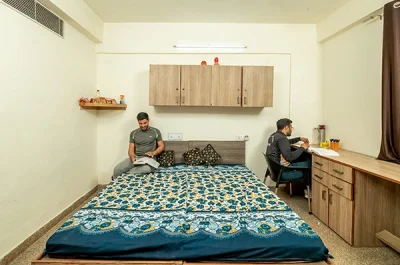
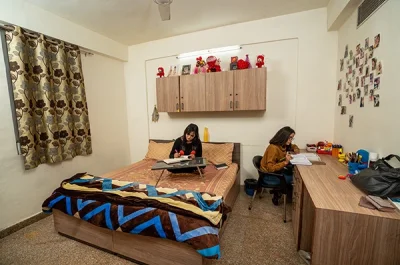
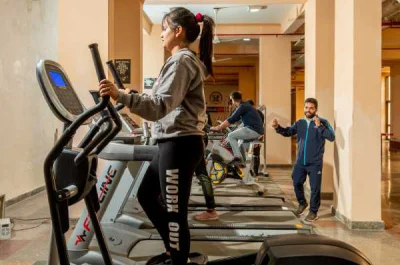



Making a Difference Together
Impacting Lives
It allows young students to participate in various government-led community service activities & programmes. The objective of KRMU-NSS is to develop responsible personalities through community service.
The programme aims to promote social welfare in students to serve society equally. NSS volunteers work closely with villagers and learn to live satisfactorily with limited resources. They also assist villagers with essential commodities such as food, clothing, and first-aid facilities during uncertainties. Under NSS, volunteers help the deprived section of society raise their living standard to live with dignity.
Community Engagement and Understanding
- Enabling students to understand the roots of the community
- Identifying their responsibilities towards the community
- Understanding the requirements and pain-points of the community and offering robust solutions
Personal Growth and Responsibility
- Developing social and civil responsibility
- Acquiring skills to live in groups harmoniously by sharing duties
- Attaining leadership qualities, democratic attitude, and skills to encourage community participation
Crisis Management and Preparedness
- Developing abilities to manage emergencies and national disasters
- Practicing national integration and social accord
A Treasure Trove of Learning Resources
The KRMU library is not just a collection of books; it’s a gateway to knowledge. With thousands of volumes, journals, and digital resources, it’s a quiet haven for thinkers, creators, and dreamers.

